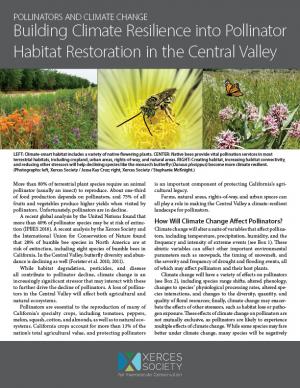
More than 80% of terrestrial plant species require an animal pollinator (usually an insect) to reproduce. About one-third of food production depends on pollinators, and 75% of all fruits and vegetables produce higher yields when visited by pollinators. Unfortunately, pollinators are in decline.
A recent global analysis by the United Nations found that more than 40% of pollinator species may be at risk of extinction (IPBES 2016). A recent analysis by the Xerces Society and the International Union for Conservation of Nature found that 28% of bumble bee species in North America are at risk of extinction, including eight species of bumble bees in California. In the Central Valley, butterfly diversity and abundance is declining as well (Forister et al. 2010, 2011).
While habitat degradation, pesticides, and disease all contribute to pollinator decline, climate change is an increasingly significant stressor that may interact with these to further drive the decline of pollinators. A loss of pollinators in the Central Valley will affect both agricultural and natural ecosystems.
Pollinators are essential to the reproduction of many of California’s specialty crops, including tomatoes, peppers, melon, squash, cotton, and almonds, as well as to natural ecosystems. California crops account for more than 13% of the nation’s total agricultural value, and protecting pollinators is an important component of protecting California’s agricultural legacy.
Farms, natural areas, rights-of-way, and urban spaces can all play a role in making the Central Valley a climate-resilient landscape for pollinators.
